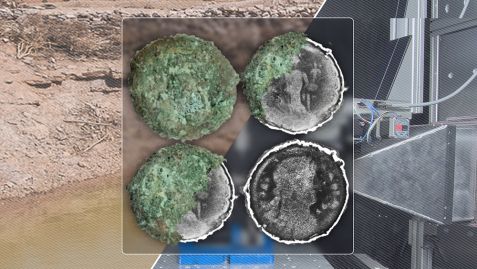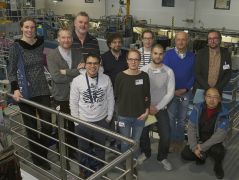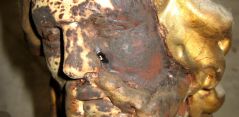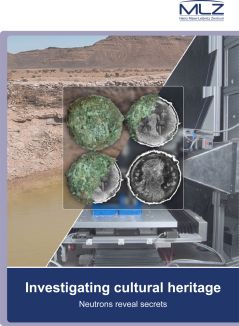MLZ is a cooperation between:
 > Technische Universität München
> Technische Universität München > Helmholtz-Zentrum Hereon
> Helmholtz-Zentrum Hereon
 > Forschungszentrum Jülich
> Forschungszentrum Jülich
MLZ is a member of:
 > LENS
> LENS > ERF-AISBL
> ERF-AISBL
MLZ on social media:

MLZ (eng)
Lichtenbergstr.1
85748 Garching
10.07.2020
Cooperation throughout Europe in research on cultural heritage

These greek coins from the Collection of the Queen's University in Kingston have been examined at the neutron imaging facility ANTARES at MLZ. © Reiner Müller
Taking a look into ancient vases or exploring the forging technique of ancient Indian swords – archaeologists can now do this and much more at the Heinz Maier-Leibnitz Zentrum within the IPERION HS project. The EU has been supporting the 68 participating institutes since April with a total of 6.2 million euros over a period of three years.
The EU-funded infrastructure project IPERION HS (Integrated Platforms for the European Research Infrastructure on Heritage Science) was launched on 1 April 2020. As part of the ESFRI roadmap (European Strategy Forum on Research Infrastructures, www.esfri.eu), IPERION HS is thus setting out to establish the conditions for a pan-European infrastructure in the field of Heritage Science (cultural heritage research) by the start of the operational phase of the E-RIHS (European Research Infrastructure on Heritage Science) research infrastructure network in 2023.
IPERION HS currently involves 23 countries (including the non-EU countries Israel, Mexico, Brazil and the United States of America) with 68 research institutions with outstanding achievements in the interdisciplinary field of conservation science, archaeology, building and materials science etc. This opens up cross-border access for numerous scientists and restorers to state-of-the-art stationary scientific analysis (FIXLAB), mobile examination methods (MOLAB), physical data collections and archives (ARCHLAB) as well as to a developing platform of digitized data (DIGILAB).The project activities in Germany are coordinated by the Stiftung Preußischer Kulturbesitz (SPK).
Scientists have access to large scale research facilities
IPERION HS enables researchers to use non-transportable technical equipment of large and medium-sized facilities for their investigations. This allows research to be carried out at highly specialised equipment such as particle accelerators, mass spectrometers or neutron sources. In addition, special laboratory facilities such as ultra-pure laboratories, e.g. for molecular genetic investigations or ultra-trace analysis, are also involved.
Users can be natural scientists of different disciplines. On the other hand, representatives of the historical sciences from archaeology to art and general history as well as restorers, monument conservators and small and medium-sized enterprises active in cultural heritage research are also eligible. In this context, academic as well as industrial interested parties can submit single or multi-analysis applications.
Research on cultural heritage at the Heinz Maier-Leibnitz Zentrum (MLZ)
In cooperation with the German coordinator, the Rathgen Research Laboratory of the National Museums in Berlin – Foundation of Prussian Cultural Heritage, the Heinz Maier-Leibnitz Zentrum (MLZ) supports the research and preservation of material cultural heritage as FIXLAB in the consortium of IPERION HS.
Measurements are carried out using the specific neutron instrumentation which is optimal for a particular application. Those for cultural heritage are mainly concerned with material analysis, imaging, and element analysis. Neutrons penetrate objects of cultural significance non-destructively, analyze the substances of which they are made and reveal hidden inner structures. They provide clues as to the origin of the substance, or the method by which the manufactured item was handcrafted.
Further descriptions of examples can be found at the webpages of MLZ and in the flyer.
Contact IPERION HS
Prof. Dr. Stefan Simon
s.simon@smb.spk-berlin.de
Dr. Andreas Furche
a.furche@smb.spk-berlin.de
Rathgen-Forschungslabor
Staatliche Museen zu Berlin – Stiftung Preußischer Kulturbesitz
Schloßstraße 1a
14059 Berlin
Website
www.iperionhs.eu
Further information on the scientific use of the instruments:
Technical University Munich
Research Neutron Source Heinz Maier-Leibnitz (FRM II)
Heinz Maier-Leibnitz-Zentrum (MLZ)
Lichtenbergstraße 1
D-85748 Garching
+49 (0)89 289 14965
mlz@mlz-garching.de
www.frm2.tum.de
www.mlz-garching.de
Partners in the German consortium are the following institutions:
• Heinz Maier-Leibnitz Zentrum of the Technical University of Munich,
• Institut für Technische und Makromolekulare Chemie of the RWTH Aachen,
• Doerner Institut der Bayerischen Staatsgemäldesammlungen,
• Fraunhofer-Institut für Bauphysik,
• Curt-Engelhorn-Zentrum Archäometrie,
• Competence Center Archaeometry Baden-Württemberg of the Eberhard Karls University Tübingen,
• Deutsches Archäologisches Institut
Related News
Flyer
MLZ is a cooperation between:
 > Technische Universität München
> Technische Universität München > Helmholtz-Zentrum Hereon
> Helmholtz-Zentrum Hereon
 > Forschungszentrum Jülich
> Forschungszentrum Jülich
MLZ is a member of:
 > LENS
> LENS > ERF-AISBL
> ERF-AISBL
MLZ on social media:






